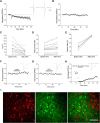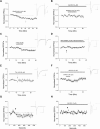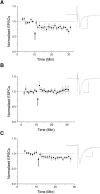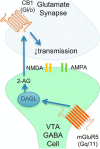CB1-Dependent Long-Term Depression in Ventral Tegmental Area GABA Neurons: A Novel Target for Marijuana
- PMID: 29038246
- PMCID: PMC5678024
- DOI: 10.1523/JNEUROSCI.0190-17.2017
CB1-Dependent Long-Term Depression in Ventral Tegmental Area GABA Neurons: A Novel Target for Marijuana
Abstract
The VTA is necessary for reward behavior with dopamine cells critically involved in reward signaling. Dopamine cells in turn are innervated and regulated by neighboring inhibitory GABA cells. Using whole-cell electrophysiology in juvenile-adolescent GAD67-GFP male mice, we examined excitatory plasticity in fluorescent VTA GABA cells. A novel CB1-dependent LTD was induced in GABA cells that was dependent on metabotropic glutamate receptor 5, and cannabinoid receptor 1 (CB1). LTD was absent in CB1 knock-out mice but preserved in heterozygous littermates. Bath applied Δ9-tetrahydrocannabinol depressed GABA cell activity, therefore downstream dopamine cells will be disinhibited; and thus, this could potentially result in increased reward. Chronic injections of Δ9-tetrahydrocannabinol occluded LTD compared with vehicle injections; however, a single exposure was insufficient to do so. As synaptic modifications by drugs of abuse are often tied to addiction, these data suggest a possible mechanism for the addictive effects of Δ9-tetrahydrocannabinol in juvenile-adolescents, by potentially altering reward behavioral outcomes.SIGNIFICANCE STATEMENT The present study identifies a novel form of glutamatergic synaptic plasticity in VTA GABA neurons, a currently understudied cell type that is critical for the brain's reward circuit, and how Δ9-tetrahydrocannabinol occludes this plasticity. This study specifically addresses a potential unifying mechanism whereby marijuana could exert rewarding and addictive/withdrawal effects. Marijuana use and legalization are a pressing issue for many states in the United States. Although marijuana is the most commonly abused illicit drug, the implications of legalized, widespread, or continued usage are speculative. This study in juvenile-adolescent aged mice identifies a novel form of synaptic plasticity in VTA GABA cells, and the synaptic remodeling that can occur after Δ9-tetrahydrocannabinol use.
Keywords: THC; TRPV1; anandamide; endocannabinoid; mGluR5; withdrawal.
Copyright © 2017 the authors 0270-6474/17/3710943-12$15.00/0.
Figures








Similar articles
-
Prenatal Ethanol Exposure Persistently Alters Endocannabinoid Signaling and Endocannabinoid-Mediated Excitatory Synaptic Plasticity in Ventral Tegmental Area Dopamine Neurons.J Neurosci. 2017 Jun 14;37(24):5798-5808. doi: 10.1523/JNEUROSCI.3894-16.2017. Epub 2017 May 5. J Neurosci. 2017. PMID: 28476947 Free PMC article.
-
Chronic Δ9-tetrahydrocannabinol impact on plasticity, and differential activation requirement for CB1-dependent long-term depression in ventral tegmental area GABA neurons in adult versus young mice.Front Neurosci. 2023 Jan 9;16:1067493. doi: 10.3389/fnins.2022.1067493. eCollection 2022. Front Neurosci. 2023. PMID: 36699526 Free PMC article.
-
CB1 Receptor Activation on VgluT2-Expressing Glutamatergic Neurons Underlies Δ9-Tetrahydrocannabinol (Δ9-THC)-Induced Aversive Effects in Mice.Sci Rep. 2017 Sep 26;7(1):12315. doi: 10.1038/s41598-017-12399-z. Sci Rep. 2017. PMID: 28951549 Free PMC article.
-
Release of endogenous cannabinoids from ventral tegmental area dopamine neurons and the modulation of synaptic processes.Prog Neuropsychopharmacol Biol Psychiatry. 2014 Jul 3;52:24-7. doi: 10.1016/j.pnpbp.2014.01.019. Epub 2014 Feb 2. Prog Neuropsychopharmacol Biol Psychiatry. 2014. PMID: 24495779 Free PMC article. Review.
-
Endocannabinoid release from midbrain dopamine neurons: a potential substrate for cannabinoid receptor antagonist treatment of addiction.Neuropharmacology. 2005 Jun;48(8):1105-16. doi: 10.1016/j.neuropharm.2005.03.016. Neuropharmacology. 2005. PMID: 15878779 Review.
Cited by
-
One Is Not Enough: Understanding and Modeling Polysubstance Use.Front Neurosci. 2020 Jun 16;14:569. doi: 10.3389/fnins.2020.00569. eCollection 2020. Front Neurosci. 2020. PMID: 32612502 Free PMC article. Review.
-
Cannabinoid disruption of learning mechanisms involved in reward processing.Learn Mem. 2018 Aug 16;25(9):435-445. doi: 10.1101/lm.046748.117. Print 2018 Sep. Learn Mem. 2018. PMID: 30115765 Free PMC article. Review.
-
ABHD6 loss-of-function in mesoaccumbens postsynaptic but not presynaptic neurons prevents diet-induced obesity in male mice.Nat Commun. 2024 Dec 16;15(1):10652. doi: 10.1038/s41467-024-54819-5. Nat Commun. 2024. PMID: 39681558 Free PMC article.
-
Increased Mesostriatal Intrinsic Connectivity Associated With Cue Exposure in Adult Cannabis Users: Preliminary Findings.Addict Biol. 2025 Aug;30(8):e70067. doi: 10.1111/adb.70067. Addict Biol. 2025. PMID: 40776400 Free PMC article.
-
Molecular Alterations of the Endocannabinoid System in Psychiatric Disorders.Int J Mol Sci. 2022 Apr 26;23(9):4764. doi: 10.3390/ijms23094764. Int J Mol Sci. 2022. PMID: 35563156 Free PMC article. Review.
References
Publication types
MeSH terms
Substances
Grants and funding
LinkOut - more resources
Full Text Sources
Other Literature Sources
Molecular Biology Databases
Research Materials
